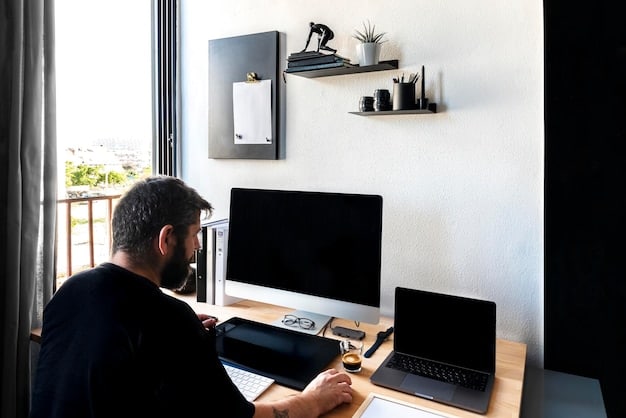Remote Work Article – remote_wor_digitalbuckzcom_15_1750264177_0b4fcd50_remote_wor.html

Remote work’s future in the US over the next five years is projected to include increased adoption, technological advancements, and evolving workplace policies impacting both companies and employees.
The landscape of work is rapidly changing, and the **remote work and the future of work: predictions for the next 5 years in the US** are becoming increasingly relevant. As technology advances and employee expectations evolve, understanding these shifts is crucial for businesses and individuals alike.
The Rise of Remote Work: A US Perspective
The shift towards remote work has been accelerated by recent global events, but its roots run deeper. Economic factors, technological advancements, and changing employee preferences have all contributed to its rise.
Historical Context
Remote work isn’t a new concept, but its widespread adoption is relatively recent. Previously, limited technology and cultural resistance hindered its growth.
Driving Forces Behind Remote Work
Several factors have propelled remote work into the mainstream including technological accessibility with improved internet speeds and cloud-based tools, economic benefits such as reduced overhead costs and increased productivity, and changing employee expectations with greater demand for work-life balance.
- Improved technology and connectivity
- Cost savings for employers and employees
- Increased employee satisfaction and retention
Before the pandemic, less than 5% of the US workforce worked remotely full-time. Now, that number has significantly increased, and many companies are planning to maintain a hybrid or fully remote model.

Remote work is becoming entrenched in the US, with both positive and negative impacts on the economy, businesses, and workers. While companies can save on real estate and access a larger talent pool, employees are now enjoying more flexible schedules and location independence.
Prediction 1: Hybrid Models Will Dominate
The future of work isn’t entirely remote or in-office. Hybrid models, which blend remote and in-office work, will likely become the dominant approach.
What is a Hybrid Model?
A hybrid model typically involves employees working remotely for a portion of the week and coming into the office for the remaining days.
Benefits of Hybrid Work
Hybrid work offers a balance between the flexibility of remote work and the collaboration benefits of in-office interaction.
- Enhanced flexibility for employees
- Opportunities for in-person collaboration
- Better work-life balance
Companies are experimenting with different hybrid approaches. Some allow employees to choose their remote days, while others specify certain days for in-office work. The key is finding a model that works for the organization and its employees.
The increasing focus will be also on intentionality in hybrid environments where in-office days are used for team-building, strategic planning, and complex problem-solving, while remote days are designed for focused work.
Prediction 2: Technology Will Further Enable Remote Work
Technological advancements will continue to play a crucial role in enabling and enhancing remote work.
The Role of Collaboration Tools
Tools like Zoom, Slack, and Microsoft Teams have already transformed remote collaboration, and they will continue to improve with features like enhanced video conferencing, virtual whiteboards, and AI-powered assistance. They will need updates to deal with things previously done in the office, in person, like team building.
Virtual Reality and the Metaverse
Virtual reality (VR) and the metaverse could revolutionize remote work by creating immersive virtual workspaces where employees can interact as if they were in the same physical location. It will be a long adoption cycle though.
- Immersive virtual workspaces
- Realistic interactions and collaboration
- Enhanced training and simulations

Many companies will invest in better hardware for remote employees: powerful laptops, noise-canceling headsets and ergonomic furniture. Tech will continue improving the remote work experience.
Companies will rely also in better cybersecurity protocols to protect sensitive data in remote environments. VPNs, multi-factor authentication, and endpoint protection are now essentials.
Prediction 3: Remote Work Policies Will Evolve
As remote work becomes more common, companies will need to develop clear and comprehensive remote work policies.
Key Policy Considerations
These policies will address issues such as eligibility for remote work, performance expectations, communication protocols, and data security requirements. It will cover topics like reimbursement for home office expenses and stipends for internet and phone services.
Companies will need to define clear performance metrics for remote employees, focusing on outcomes rather than hours worked. Project management tools will be essential here to track progress, assign tasks, and measure performance.
- Clear guidelines and expectations
- Performance metrics and accountability
- Support for employee well-being
Clear policies will be important to support the wellbeing of remote workers, including flexible work hours, mental health resources, and virtual team-building activities.
As companies grapple with legal and tax implications of remote work, especially regarding employees working in different states or countries, that will need to comply with local labor laws and tax regulations.
Prediction 4: The Talent Pool Will Expand
Remote work opens up access to a much broader talent pool, allowing companies to hire the best people regardless of location.
Benefits of a Larger Talent Pool
This can lead to more diverse and skilled workforces, ultimately boosting innovation and productivity. Companies can tap into specialized skills and expertise that may not be available locally.
Challenges of Managing a Distributed Team
Managing a distributed team requires new skills and strategies including effective communication, cultural sensitivity, and the ability to build trust remotely.
- Access to specialized skills
- Increased diversity and innovation
- Greater flexibility in hiring
Companies will need to invest in training for managers to effectively lead remote teams, focusing on communication, collaboration, and performance management.
Diversity and inclusion initiatives are becoming increasingly important like ensuring that remote work opportunities are available to all employees, regardless of their background or location.
Prediction 5: Remote Work Will Impact Urban Areas
The rise of remote work has significant implications for urban areas, affecting real estate markets, transportation patterns, and local economies.
Impact on Real Estate
As more people work remotely, demand for office space in city centers may decrease, while demand for housing in suburban and rural areas could increase. This can lead to shifts in real estate prices and investment patterns.
Changes in Transportation and Infrastructure
Reduced commuting could alleviate traffic congestion and pollution in urban areas, but it also may require adjustments to public transportation systems.
- Shift in real estate demand
- Reduced commuting and congestion
- Changes in local economies
Local governments need to adapt to the changing needs of their communities, providing resources and support for remote workers and addressing potential economic impacts.
The economy will shift more to the service sector. Local businesses and service providers must cater more to residents and develop other offerings.
Frequently Asked Questions About Remote Work
Conclusion
The future of remote work in the US is dynamic and evolving! In the coming years, we can expect to see hybrid models becoming the norm, technology further enabling remote collaboration, and companies developing more comprehensive remote work policies. Additionally, the talent pool will expand, and urban areas will experience significant impacts. Staying informed and adaptable is key to navigating this changing landscape successfully.





